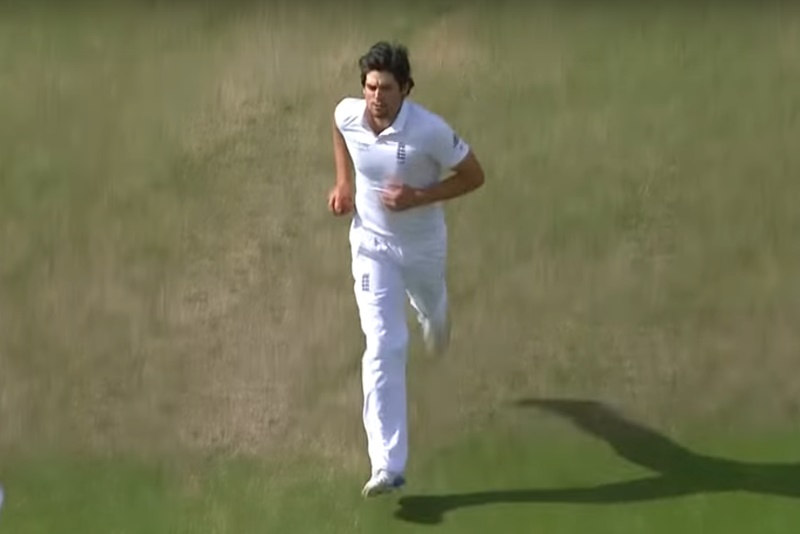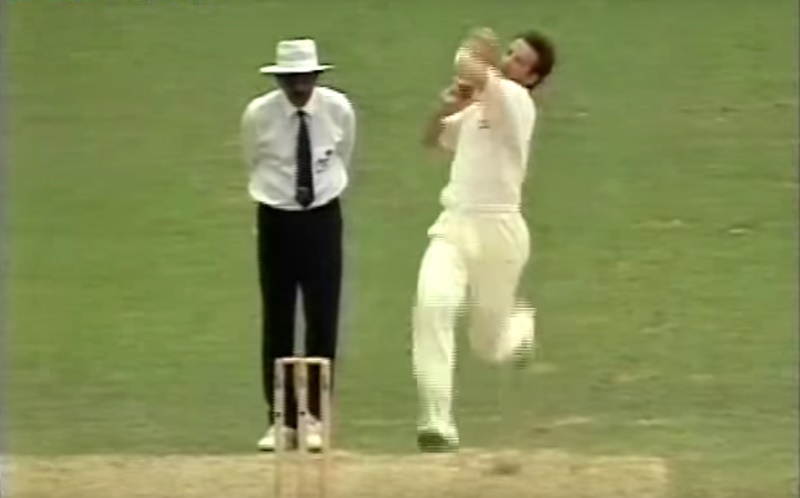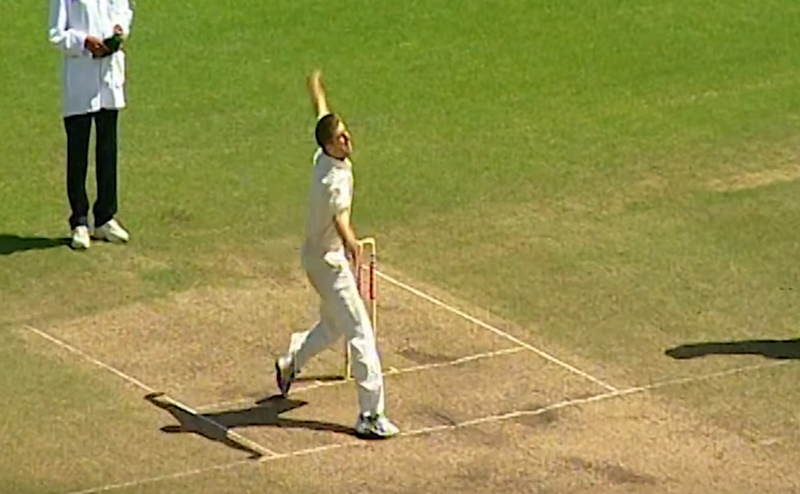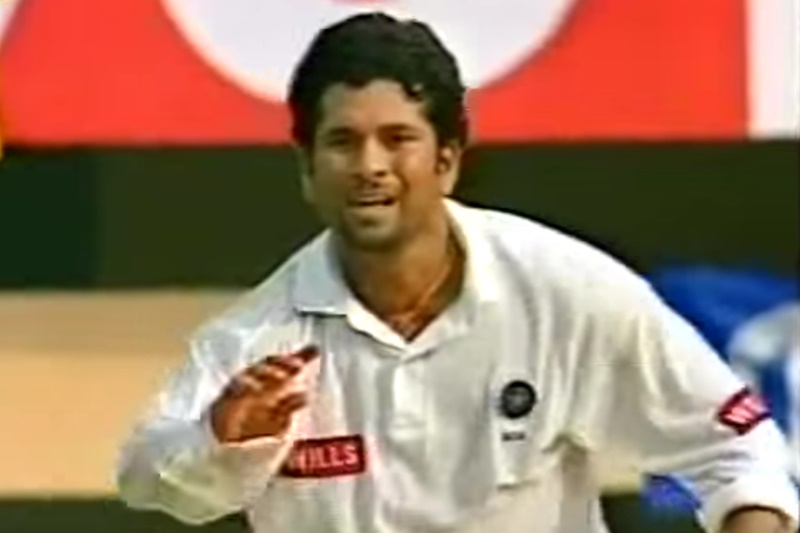All-rounders are great, but part-time bowlers are more entertaining. Bowlers have to bat in Test cricket, even though they are not picked as batsmen – but only very occasionally is a batsman asked to bowl. Let’s try and work out which Test cricketer who wasn’t picked for his bowling was the best at bowling.
All-roundering is a fun thing to talk about because it lies on a continuum. Between the players who are only really picked to bat and the players who are only really picked to bowl lie assorted misshapes.
Different teams have different holes in them and so they need different pieces to complete them. One team might want a run-scorer who can be relied upon to get through a few overs of economical fast-medium. Another might have a vacancy for a frontline bowler who can hang around and make 20-odd with the bat.
At some point on that continuum you reach a point where no-one really honestly cares about your bowling, but you do still occasionally get asked to bowl.
Goldenarms
The part-time bowler is a very particular tool. You’re not going to have a big workload. You’re not going to bowl every match. And when you do bowl, you’re probably going to get taken off again pretty soon, regardless of how well you perform.
In fact there’s almost a case for saying that the perfect part-time bowler would be someone who comes on, instantly takes a wicket, and is then immediately whipped out of the attack.

Because part-time bowlers are, more than anything, partnership breakers. They’re a somewhat desperate roll of the dice. You bring on your part-time bowler when things are shit and you hope that you hit that bullseye and that the rest of the dominoes fall like a house of cards and it’s checkmate.
So that’s kind of what we’re looking for here.
Qualification criteria
This is a tricky one.
Test cricket’s greatest part-time bowler will need to have a certain body of work to justify that title – but the very nature of part-time bowling means that necessitates a lengthy career.
What we’re saying is, we need someone who played enough for us to know that they didn’t bowl much.
Let’s set a lower limit of 10 wickets because any less than that is too little to evaluate.
At the opposite end, let’s go for 100 wickets because more than that is just too many.
Let’s see what that gives us.
Most wickets
A lot of specialist bowlers have taken between 10 and 100 Test wickets. Working our way down the list, Sanath Jayasuriya is the first with fewer wickets to his name than Test appearances.
Jayasuriya played 110 Tests and took 98 wickets. This doesn’t seem very part-time to us. He’s maybe not doing a full-time job exactly, but he’s certainly around for the majority of the week and sometimes he stays late.
We feel like we have to exclude Jayasuriya. The man took 323 wickets in one-day internationals, for crying out loud. That puts him at number 11 in the all-time list – ahead of Shane Warne and absolutely everyone who’s ever played for England. That is not a part-time bowler.
The next man with more appearances than wickets is Steve Waugh. Let’s weigh up his case.
Waugh took 92 wickets in 168 Tests at an average of 37.44.
Is that the record of a part-time bowler? Or is that the record of someone at the very battingest end of the all-rounder spectrum?
> Who is Test cricket’s greatest number eight? (Which Test bowler was the best batsman?)
Waugh averaged 7.7 overs a Test match, which is not a lot, but also not a little. He also took three five wicket hauls. That feels quite all-roundery – but then it was in the space of 168 Test matches, so maybe we should give him the benefit of the doubt. Although throw in four four-wicket hauls and we don’t know. It feels a little incriminating.
You may have noted that 92 wickets in 168 Tests is more than a wicket every other Test. That’s starting to feel like a concrete thing we should stick to. If you’re taking less than half a wicket a Test, it seems safe to assume you’re not considered a key part of the bowling attack.
That threshold would easily rule in Sachin Tendulkar, who took 46 wickets in 200 Tests, bowling all sorts of random stuff; while ruling out Greg Chappell, who took 47 wickets in 87 Tests, bowling 10 overs a Test match.
It also rules in Virender Sehwag (40 wickets in 104 Tests) and Allan Border (39 in 156), while ruling out Chris Gayle (73 in 103) and Hansie Cronje (43 in 68).
That feels about right. (If only because we don’t really want Cronje coming out on top here, do we?) (Also, it’s worth pointing out that Gayle bowled over 1,000 Test overs. That’s not part-time.)
This moves us on a lot. Or actually not very much at all because it turns out the top wicket-taker to have taken less than a wicket every other Test is Steve Waugh’s twin brother.

Mark Waugh took 59 wickets in 128 Tests at an average of 41.16.
Some will tell you that he’s an all-rounder on the basis that he averaged more than that with the bat. To that we can only counter with the fact that Alastair Cook averaged 7.00 with the ball in Test cricket.
The fact of the matter is that Mark Waugh averaged just over six overs a Test match and recorded one five-for, one four-for and one three-for in 128 Test matches.
That is a part-time bowler.
If we’re rating the best part-time bowler by how many wickets they took, Mark Waugh is the best.
But maybe we’re not rating them like that.
Best average
Darren Lehmann warrants a quick mention here for having taken 15 wickets in 27 Tests at 27.46. Had Boof played three more Tests and failed to bowl in them, he’d have topped the list.
But he didn’t.
The next man, we’d say, is our winner here.

Simon Katich took 21 wickets in 56 Tests at 30.23, delivering, on average, just three overs of left-arm wrist spin per match.
This is undeniably part-time, but Katich was also undeniably effective. That bowling average is superior to Matthew Hoggard, Peter Siddle and Yasir Shah. It’s better than Brett Lee.
And then there’s the small matter of his strike-rate. This, for us, is where Katich makes his case.
As we wrote several hundred words ago, the ideal part-time bowler is someone who comes on, instantly takes a wicket, and is then immediately whipped out of the attack.
You’re looking for instant impact. A part-timer isn’t a fill-in bowler; he’s a spanner flung optimistically into the opposition’s works. You bring on a part-timer when you’re hoping to magically turn a hopeless position around.
Simon Katich’s strike-rate is 49.4. Simon Katich took a Test wicket every 49.4 deliveries.
That strike-rate is the same as Fred Trueman’s.
Simon Katich has a better Test strike-rate than Richard Hadlee, Michael Holding, Mitchell Johnson, Lasith Malinga and Glenn McGrath.
Simon Katich is the greatest part-time bowler in the history of Test cricket.
Thanks to everybody who’s currently funding King Cricket on Patreon. Your pledges help us do features like this. If you’re not currently a King Cricket patron and you’d like to see us to do more with the site, you can flip us a shiny coin or buy us a pint each month here. Don’t feel you have to, but huge thanks if you do.
Further reading: Two dismissals and over – who was Test cricket’s busiest wicketkeeper?
Want to get King Cricket articles by email? You can sign up for that here



The man I instantly thought of was Michael Bevan, Strike Rate 44, Average 24. Don’t let the stats deceive you, it really was 43 long hops and one deadly delivery every 44 balls.
Bevo’s a good shout. Just too many wickets for our definition – in large part because of that 10-for.
He bowled before Warne in both innings. In the second innings, he actually bowled two overs more than Warne did.
(I wonder how Warne took that)
I dunno KC, feels like you are being a bit too generous here. Kat has 107 FC wickets and a Test five-for.
You need stricter constraints! Best figures with <= 2 wickets? Took wickets in Tests but not in other FC matches? Got wickets bowling more than one style? Played at keeper?
Filtering for keepers a great "impact bowler": Alfred Lyttelton – 4 Test wickets in 4 matches (all in one spell of in 48 underarm lobs). No other FC wickets. Legend.
Mhd Ashraful stands out for "least-best figures" of 2/42 while having 21 Test wickets (albeit 198 FC wickets).
107 wickets in 266 matches feels pretty part-time to us – and that’s at a lower level. He DEFINITELY wasn’t being picked to bowl for Australia based on that record.
I think “part-time” is the wrong paradigm for these guys. I remember my school had some part-time teachers. They turned up for work regularly, but it might only be two days per week. They’d teach some classes, quite possibly sharing duties with other teachers (you’d have the part-timer once a fortnight, the full-timer twice a fortnight) but they were regular contributors to the whole teaching lark, and you did expect to see them when you were timetabled for them.
What you’re really after isn’t cricket’s version of the supply teacher. Someone not on the timetable, when they turn up to teach you it’s a surprising event, they probably don’t even make a living from teaching – they did other things to earn most of their crust – but nevertheless, they were a trained and somewhat competent teacher, who tended to deliver a lesson that was quite unlike your usual diet (rarely stuck to the syllabus) and therefore thoroughly entertaining. Generally weren’t too tight on the discipline front either.
I will leave it to Bert to determine what the statistical criteria for the supply-teacher equivalent should be but I think “surprising” is the main thing. Perhaps a certain proportion of Tests in which they did not bowl at all, though with some filtering-out for all-rounders who evolved into specialist batsmen. Intermittent spells of bowling throughout their Test career, appearing more or less at random, would be a strong indicator for me.
I meant “is* cricket’s version”, not “isn’t”. I would blame autocorrect but was typing on my laptop. I will blame my butterfingers instead, attempting the sportsperson’s excuse of attempting to pass blame on to the relevant body part that’s merely anatomically attached to them and nothing else to do with them at all.
Mark Butcher? Doesn’t beat Katich, but feel he should be mentioned in despatches.
Paul Collingwood was always called an all rounder but his test bowling (17 wickets at 60 in 68 tests) is well in the part timer realm, and even at the rubbish end of that realm.
Except that he was Paul Collingwood, arguably England’s finest ever player, so he is a batting all rounder and I’ll not entertain a contrary opinion.
You are letting the facts get in the way of sentiment, KC.
Your subjects don’t want the answer to be Simon Katich. We demand a recount. We can only assume that widespread fraud led to the answer we didn’t want.
Sack people.
Sort it out.
It’s also worth pointing out that Katich’s 6fer that significantly boosts his stats came against Zimbabwe in the same series that included Hayden’s hideous 380, which definitely reeks of fraud.
Ged’s case is strong KC – it’s well-known that when Katich’s wickets were counted in that shack where they count wickets, no non-Australians were allowed anywhere near. This reeks of fraud it does.
Ballance was robbed
Your maj, I submit that the Criteria to decide between all rounder vs part timer is rather arbitrary. Instead we should a far more rigorous standard such as what is my first thought of the bloke. Thus gayle is the man with golden arm. Because I can’t remember a single instance of him bowling. Not that we could be bothered to look it up.
You sir must be lithe and young, for Chris Gayle bowled plenty before he turned into a giant concrete bollard with a bat.
Or old and forgetful. But think it says much about your good grace, Yer Maj, that you opted for lithe and young.
I remember Gayle’s bowling trademark as being an annoying ‘aborted’ run-up to anyone who was just short of a batting milestone, to put them on edge.
He may have done this as many as one or two times.
I’m a bit worried that the conclusion to this article is that Australia’s ’90-’00s side was so good that even their specialist batsman were great bowlers. One might start to credit their mentality.
Why did a side with such a strong regular bowling line-up even need extra part-time bowlers? That’s a mystery in itself, though I suppose their lack of an outright all-rounder goes some way to explain it. I reckon if the Aussie bowling attack of that time had been weaker, a couple of these candidates would actually have been deployed as all-rounderishes.
shame we cant just say that Alister Cook is the best bowler of all time
Cook’s figures should by rights just be added onto Bob Willis’, given that he was doing an impression at the time.
Looking at the arse end of the strike rates of people who have 10 wickets list is quite interesting. Clive Lloyd has the worst strike rate at 171.6, with Viv Richards and Larry Gomes 3rd and 4th worst respectively. I wonder if this was due to the West Indies utmost conviction to the 4 fast bowlers strategy in this period that when a team actually batted OK against them and the quicks got tired these part timers had to bowl a lot more than their skill warranted.
Also, if conditions were such that Malcolm Marshall couldn’t take a wicket then the part-timers were probably on a hiding to nothing.
I move the qualification criteria be amended to exclude anyone who played in a strong bowling side. They would have really come on just to give the main bowlers a breather, and the opposition batsmen would have gotten out trying their damndest to hit them out of the ground. They wouldn’t be a hopeful spanner tossed at the opposition’s works as much as a spanner placed there while the wrench was getting de-greased to do its thing.
This would also have the advantage of removing most of the Aussies on this list.